| Heteractis magnifica | |
|---|---|
_in_Heteractis_magnifica_(Magnificent_sea_anemone).jpg.webp) | |
| Heteractis magnifica with Amphiprion perideraion | |
| Scientific classification | |
| Domain: | Eukaryota |
| Kingdom: | Animalia |
| Phylum: | Cnidaria |
| Class: | Hexacorallia |
| Order: | Actiniaria |
| Family: | Stichodactylidae |
| Genus: | Heteractis |
| Species: | H. magnifica |
| Binomial name | |
| Heteractis magnifica | |
| Synonyms | |
|
List
| |
Heteractis magnifica, also known by the common names magnificent sea anemone or Ritteri anemone, is a species of sea anemone belonging to the Stichodactylidae family native to the Indo-Pacific area.
Description
The magnificent sea anemone is characterized by a flared oral disc, which reaches between 20 and 50 cm in diameter, but in some specimens, this can reach 1 m.[1] The oral disc, the base of the tentacles, and the oral orifice have the same color, going from light beige to white.
The numerous tentacles exceed 8 cm long. The sea anemone, being a member of the Hexacorallia, usually carries tentacles in multiples of six that are positioned in concentric circles. Their tips are fingered and often lighter in coloration than the tentacle body and are sometimes vividly colored.
Its specific scientific name, magnifica, and its vernacular name come from the bright color of the column, which is the visible outer structure when the animal retracts, and these range from electric blue to green, red, pink, purple, or brown.
Distribution and habitat
The magnificent sea anemone is widespread throughout the tropical and subtropical waters of the Indo-Pacific area, from the eastern coasts of Africa, the Red Sea included, to Polynesia and from south Japan to Australia and New-Caledonia[2][3]
This anemone likes hard substrates well exposed to light and current from the surface to 20 m deep.[2] It has been observed down to 40 m deep.[4]
Biology
The magnificent sea anemone has two feeding methods. The first one is through the photosynthesis of its symbiotic zooxanthellae, living in its tissues. The second method is through using its tentacles to stun, immobilize, and consume prey (small invertebrates, fry, or juvenile fish).
The reproduction of the anemone can be sexual by simultaneous transmission of male and female gametes in the water or asexual by scissiparity,[5] which means that the anemone divides itself into two individuals, separating from the foot or the mouth. The magnificent sea anemone is found as solitary specimens throughout its range with aggregations only being found in the rim areas of its distribution. Genetic analyses does not suggest a difference between solitary specimens in the central distribution and clustering specimens at the rim. Asexual reproduction is found only in the rim areas and is probably the origin of the large aggregations.[4]
The relationship between anemonefish and their host sea anemones is highly nested in structure. With 12 species of hosted anemonefish, the magnificent sea anemone is highly generalist. The anemonefish it hosts are also mostly generalist, the exceptions being Amphiprion pacificus, only hosted by H. magnifica, and A. akallopisos, which is also hosted by Stichodactyla mertensii.[6] The species of anemonefish hosted by the magnificent sea anemone are: [7]
- Amphiprion akallopisos (skunk anemone fish)
- A. akindynos (Barrier Reef anemonefish)
- A. bicinctus (two-band anemonefish)
- A. chrysogaster (Mauritian anemonefish)
- A. chrysopterus (orange-fin anemonefish)
- A. clarkii (Clark's anemonefish)
- A. leucokranos (white-bonnet anemonefish)
- A. melanopus (red and black anemonefish)
- A. nigripes (Maldive anemonefish)
- A. ocellaris (false clown anemonefish)
- A. pacificus (Pacific anemonefish) [8]
- A. percula (clown anemonefish)
- A. perideraion (pink skunk anemonefish)
H. magnifica also hosts Dascyllus trimaculatus, the threespot dascyllus, and various commensal shrimps.
Gallery

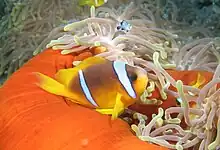
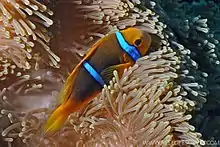
_in_Heteractis_magnifica_(Magnificent_anemone).jpg.webp)
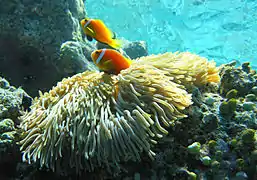

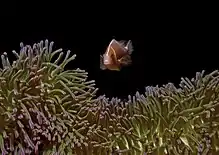 A. perideraion hovering above Heteractis magnifica (purple-tip anemone)
A. perideraion hovering above Heteractis magnifica (purple-tip anemone)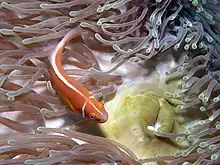
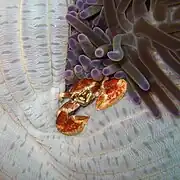 A porcelain crab Neopetrolisthes maculatus
A porcelain crab Neopetrolisthes maculatus_en_una_an%C3%A9mona_magn%C3%ADfica_(Heteractis_magnifica)%252C_mar_Rojo%252C_Egipto%252C_2023-04-18%252C_DD_113.jpg.webp)
References
- ↑ Weinberg, Steven (1996). Découvrir la mer Rouge et l'océan Indien [Discover the Red Sea and Indian Ocean] (in French). Paris: Nathan. ISBN 9782092606599.
- 1 2 Arvedlund, Michael & Nielsen, Lis Engdahl (1996). "Do the anemonefish Amphiprion ocellaris (Pisces: Pomacentridae) imprint themselves to their host sea anemone Heteractis magnifica (Anthozoa: Actinidae)?". Ethology. 102 (2): 197–211. doi:10.1111/j.1439-0310.1996.tb01118.x.
- ↑ Fautin, Daphne (2007). "Actinaria of New Caledonia". In Payri, Claude E.; Richer De Forges, Bertrand (eds.). Compendium of marine species of New Caledonia. Vol. II7 (2nd ed.). Centre IRD de Nouméa. p. 135. ISSN 1297-9635. OCLC 862735362.
- 1 2 Brolund, T.M; Tychsen, Anders; Nielsen, L.E. & Chadwick, N. E. (2005). "An assemblage of the host anemone Heteractis magnifica in the northern Red Sea, and distribution of the resident anemonefish". Journal of the Marine Biological Association of the United Kingdom. 84 (3): 671–674. doi:10.1017/S0025315404009737h. S2CID 54581276.
- ↑ Scott, Anna & Harrison, Peter L. (2007). "Embryonic and larval development of the host sea anemones Entacmaea quadricolor and Heteractis crispa". The Biological Bulletin. 213 (2): 110–121. doi:10.2307/25066627. JSTOR 25066627. PMID 17928518. S2CID 23785363.
- ↑ Ollerton, Jeff; McCollin, Duncan; Fautin, Daphne G. & Allen, Gerald R. (2007). "Finding NEMO: nestedness engendered by mutualistic organization in anemonefish and their hosts". Proceedings of the Royal Society of London B: Biological Sciences. 274 (1609): 591–598. doi:10.1098/rspb.2006.3758. PMC 1766375. PMID 17476781.
- ↑ Fautin, Daphne G. & Allen, Gerald R. (1997). Field Guide to Anemone Fishes and Their Host Sea Anemones. Western Australian Museum. ISBN 9780730983651. Archived from the original on 14 April 2015.
- ↑ Allen, G.; Drew, J. & Fenner, D. (2010). "Amphiprion pacificus, a new species of anemonefish (Pomacentridae) from Fiji, Tonga, Samoa, and Wallis Island". Aqua, International Journal of Ichthyology. 16 (3): 129–138. Archived from the original on 2015-05-27.